Introduced in May 1985, the Alfa 75 (or Milano in the USA), named to celebrate 75 years of Alfa Romeo, was developed as a successor to the Giulietta/Alfetta, and almost the entire mechanical basis was taken from the latter cars. A mid size saloon the Alfa 75 continued the unusual Alfa Romeo design of having the engine at the front and the gearbox at the rear to provide a good distribution of the weight. Only ever produced in one bodystyle, a four door saloon (drag coefficient 0.34), the Alfa 75 was the last car to use the Alfetta mechanicals. At launch, the engines were as follows : 1600 (1570cc,110bhp), 1800 (1779cc,120bhp) and 2000 (1962cc,128bhp) four cylinder units with carburettors, a 2500 fuel injection V6 in the Green Cloverleaf version (2492cc,156bhp) and a 2.0 turbo diesel (1995cc,95bhp). In the following year, 1986, the Alfa 75 turbo was introduced.
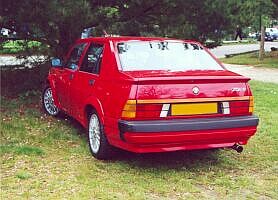
This had the 1779cc twin cam fitted with a Garrett T3 turbocharger, fuel injection, intercooler and oil-cooler, producing 155bhp. This engine was also developed for motorsport and gained some successes in a very short lived career (including 3rd overall in the 1987 Tourist Trophy at Silverstone). The competition cars were heavily developed and included such changes as coilover front suspension (replacing the torsion bars), outboard rear brakes and adjustable de dion rear suspension. Aimed at both cashing in on the competition success of the 75 turbo, and for homologation, was the 'Evoluzione', fitted with extra bodywork and a luxurious interior and sold in small numbers. In 1987 the venerable old twin-cam was redesigned to incorporate two spark plugs per cylinder (as Alfa had done in the past in various race engines) and the twin-spark was born. The 75 got the 2.0 version of this engine, which gave a healthy 148bhp, thanks also to variable valve timing and fuel injection. At the same time, Alfa released the 3.0i V6 America. Visually recognisable due to the black side stripes being body coloured, it introduced the 186bhp 3-litre version of the V6 into the 75 and was aimed at the US market, incorporating different front and rear bumpers to meet that country's legislation. 1988 saw the engines again changing, as the old carburettor fed 1800 was replaced by the 1.8IE and a new 2.4-litre turbo diesel joined the range. The 1.8IE produced the same power as the earlier version, but the Bosch Motronic fuel injection and variable valve timing enabled a better torque curve to be produced. The 2.4 TD unit, a VM engine, came complete with KKK turbocharger and intercooler. Aesthetically only very minor changes were made to these models, and various parts, such as the seats, were adopted from the Twin Spark.
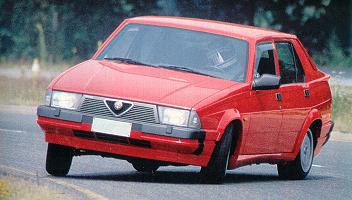
Late 1989 / early 1990 saw a 1.6IE joining the range (the carburettor 1.6 soldiered on for a while longer too) with 105bhp, whilst catalysed versions of 2.0 Twin Spark and 3.0 V6 also emerged, both suffering minor decreases in power output. Slightly later in 1990 the 1.8 Turbo America was relaunched as the 1.8 Turbo Quadrifoglio, gaining 10bhp (now 165bhp). The 3.0i V6 also gained 12bhp (up from a catalysed 180bhp to 192bhp) thanks to a new injection system, new camshafts and a new exhaust system. Both cars received revised suspension settings to handle the extra power. The Alfa 75 was well known for its quirky looks from the outside, and some unusual design features inside, such as the U-shaped handbrake, the electric window switches in the roof.... Alfa Romeo never built a coupe version of the 75, but the SZ/RZ almost fulfilled that brief..... See also our Alfa Romeo Concept Cars page for the Zender Progetto Cinque spider based on the 75. In 1986 Rayton Fissore showed their interpretation of a 75 estate, called the 'Turbowagon' (being based on the 1.8 turbo car). A pretty design, unfortunately it never made production.
The 75 was replaced in 1992 by the all new, front-wheel-drive 155.
Technical Details
| Driveline | longitudinal engine at front, gearbox at rear with rear wheel drive |
| Engines | 1570cc (78x82mm) dohc 4 cyl with 110bhp @ 5,800rpm (carburettor)
1779cc (80x88.5mm) dohc 4 cyl with 120bhp @ 5,300rpm (carburettor)
1779cc (80x88.5mm) dohc 4 cyl with 120bhp @ 5,500rpm (injection)
1962cc (84x88mm) dohc 4 cyl with 128bhp @ 5,400rpm (carburettor)
1962cc (84x88mm) dohc 4 cyl Twin Spark with variable valve timing and 148bhp @ 5,800rpm (injection)
2492cc sohc per bank V6 with 156bhp @ 5,600rpm (injection)
1779cc (80x88.5mm) dohc turbocharged & intercooled 4 cyl with 155bhp @ 5,800rpm (later 165bhp) (image)
2959cc (93x72.6mm) sohc per bank 60deg V6 with 185bhp @ 5,800rpm (later 180bhp with cat, then 192bhp @ 6,000rpm)
1995cc turbo diesel 4 cyl with 95bhp @ 4,300rpm
2393cc (92x90mm) turbo diesel 4 cyl with 110bhp @ 4,200rpm |
| Suspension | front : double wishbone with torsion bars and telescopic dampers plus anti-roll bar
rear : de Dion with transverse link, coil springs and telescopic dampers plus anti-roll bar
wheelbase : 2510mm
track (front/rear) : 1367mm/1356mm (turbo : 1398mm/1388mm) |
| Brakes | front : discs (ventilated on some models)
rear : discs (inboard)
handbrake operating the rear callipers via cable
dual hydraulic circuit with servo assistance |
| Gearbox | 5 speed manual
3 speed automatic |
| Steering | Rack and pinion
hydraulic power assistance on some versions |
| Kerb weight | 1.6 : 1090kg
3.0 V6 : 1250kg
1.8 turbo : 1240kg (front/rear : 51.6% / 48.4%) |
| Dimensions | 1.8 turbo : click here |
For general drawings of the suspension and transmission, see the Alfetta page, the differences from that model are minor.
Performance
| model | max speed | 0-100km/h | standing km | braking dist from 100km/h |
| 1.8 Turbo (1986) | 214 km/h | 7.7 sec | 28.2 sec | 45.6 m |
| 3.0i V6 America (1987) | 220 km/h | 7.9 sec | 28.8 sec | 47.1 m |
| 2.0 Twin Spark (1987) | 205 km/h | 8.5 sec | 29.4 sec | 45.5 m |
| 1.8 IE (1988) | 192 km/h | 10.2 sec | 31.5 sec | 47.3 m |
| 2.4 TD (1988) | 188 km/h | 11.3 sec | 32.7 sec | 46.8 m |
| 1.6 IE (1990) | 180 km/h | 10.9 sec | 32.4 sec | 44.9 m |
Tuning
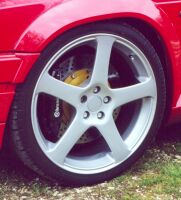
Easily carried out modifications include installation of a free-flow air filter (a cold air duct is also a worthy mod) and fitment of a less restrictive exhaust system to improve the driveability, 'Chips' are also available which (claim to) increase the power, driveability and torque all at the same time. More traditional methods such as carburettors and camshafts will also work well with this engine, and there are plenty of experts around. Obviously the turbo engine is quite easy to improve through increasing the boost, the charge cooling and the fuelling. The brakes can be improved by using a higher specification fluid, fitting drilled and grooved discs, using a superior pad compound and fitting stainless steel braided flexible hoses. Dampers and springs are readily available for the 75 which will improve the handling, and a strut brace can be fitted at the front to increase the stiffness of the bodyshell. The rubber bushes can also be replaced by items made from a less compliant material, such as nylon.
Buying / Selling
Some tips to do before selling : (they may seem obvious, but most people don't do them and thus are in a weaker bargaining position)
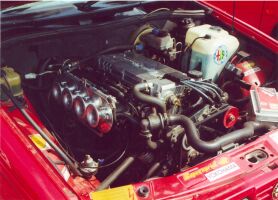
Tidy inside the car thoroughly : hoover the floor, empty all pockets, ashtrays (wash), glove compartment etc..., wipe the trim with a damp cloth, give the cockpit a good airing to get rid of any odours ! Reset the trip meter to 00000 - it is a pleasant (subconcious) surprise. If the car has been standing give it a good run - this will clear out the engine (reduce exhaust smoke), put a shine on the brake discs and loosen up any joints that may otherwise make some noises. Jetwash under the car, especially under the engine and in the wheelarches. The prospective buyer may be an enthusiast, and this makes it easier for them to see what they want to check. Even if you don't have a service history, try to find any receipts, especially for the last timing belt change.
Obviously wash the car and clean the windows !
If you are going to buy a car always check the following : Firstly check the bodywork. Check that there are no mismatching panels, large areas of discolouration or signs of fresh paint (compare inside the engine bay with the external body colour), all of which probably indicate accident damage.
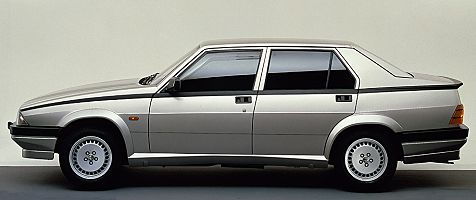
Check the main electrical functions - wipers, windows, lights, etc... try putting the main beam and wipers on at the same time. Check the headlights for cracks and make sure that the air-conditioning unit works, if fitted. Check the brake pedal does not go to the floor if pressed hard for a long time and if possible check the brake discs for wear (the front ones through the wheels). Check the gearchange for clean engagement. The engine should be run up to temperature, check the exhaust for smoke, the condition of the breather (look for mayonnaise), the condition of the oil filler cap (again white deposits can indicate head gasket or other serious problems or the use of the car only on short journeys, another bad state of affairs) and the colour of the coolant (preferably not thick or dark brown!). Listen to the noise of the engine, then depress the clutch and engage first gear. Whatever noise has disappeared was coming from the gearbox, what remains is from the engine. Also check the condition of the engine oil on the dipstick.The lighter brown the better, if it is thick black then leave quickly.
Check tyre wear, uneven patterns could imply a bent chassis. Always take it for a test drive. Check that the car tracks in a straight line with no steering input and also remains straight under braking.
Find a large open area and complete several lock to lock turns (also in reverse), listening for any noises. Try the handbrake when moving - seized rear callipers will mean uneven braking or no braking.






Nav komentāru:
Ierakstīt komentāru